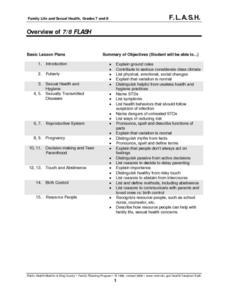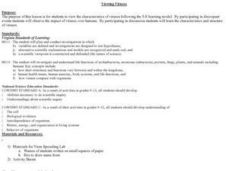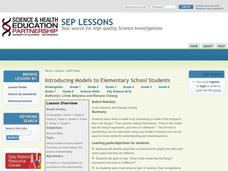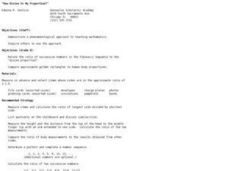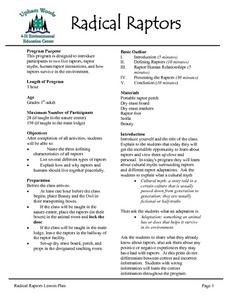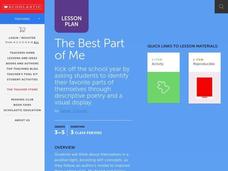Curated OER
Thematic Maps of Your School
Young scholars are able to list the essential elements of a thematic map, understand and use scale effectively to represent a geographic area, use research skills to develop a body of information, plan and draw an accurate thematic map...
Curated OER
FLASH
Students Distinguish among assertive, aggressive, passive and manipulative behaviors,Describe consequences of each,Formulate an assertive request,Describe how it feels to risk rejection. Students Describe how human immunodeficiency virus...
Curated OER
Tall Tales
Students examine the characteristics of tall tales and how exaggerations are used. They create a character that is larger than life, they brainstorm attributes for their character, before writing a Tall Tale. They plan out their story,...
Curated OER
Reformation Simulation
Learners discover the Medieval reformation. In this ethics lesson, students simulate council and government bodies to determine responses to various opinions regarding religion and ethics. They determine what postilions to take and why...
Curated OER
Scientific Thinking
Middle schoolers participate in four different activities which reinforce an understanding of they way scientists think about the world. They make careful observations of two different pennies, write the procedure for making a peanut...
Curated OER
Equal Rights
Learners experience what it would be like for any one group to make the laws that all people are to follow.
Maryland Department of Natural Resources
Eyes on Dissolved Oxygen
Learn about the factors that affect the way oxygen dissolves in salt water with a chemistry lab. After studying the molecular structure of water, young scientists figure out how aeration, temperature, and organic waste affect...
Curated OER
Microbes 1: What's Bugging You?
Students build on existing knowledge of microbes, focusing on the relationship between microorganisms and foodborne illness, as well as the implications that foodborne illness has on human health.
Curated OER
Viewing Viruses
Pupils view the characteristics of viruses following the 5-E learning model. By participating in discrepant events Students observe the impact of viruses over humans. By participating in discussion pupils examine the characteristics and...
Curated OER
Introducing Models to Elementary School Students
Students explore the concept of models. In this model activity, students examine 3-dimensional models of various objects and body parts to better understand the natural world.
Curated OER
"How Divine Is My Proportion?"
Eighth graders explore the concept of the divine proportion/golden ratio. In this Fibonacci Sequence exploratory lesson plan, 8th graders measure the length and width of various objects to see which items have a divine proportion....
Curated OER
Radical Raptors
Students are introduced to raptors and their role in the environment. They identify three characteristics of raptors and list several types of raptors found in nature. They discuss their positive and negative experiences with raptors and...
Curated OER
Air and Water in the Environment
Second graders participate in a three part lesson in which they identify and describe forms of moisture in the environment. Part one of the lesson involves the three stages of the water cycle, part two focuses on creating humidity by...
Curated OER
Edible DNA
Students use multicolored soft candies (gumdrops and candy orange slices) and toothpicks to create models of DNA structures. They discuss the fact that DNA must copy itself before splitting into two cells. Students demonstrate this by...
Curated OER
Teaching With the Power of Objects
Students define value of an object. In this value lesson plan, students identify reasons for collecting objects, compile a personal inventory of items they find valuable, and then define why those items are valuable to them. In step two...
Curated OER
Extensions - Biology Review Unit
Students engage in a variety of activities in order to review a Biology unit. For example, they research the Bird Flu, it's history, how it is spread, what has been done about it, what better options exist for controlling or removing it....
Curated OER
Movement, it's FUN-damental!
Learners discover how muscles work. In this biology lesson plan, students explain the causes of fatigue and muscle soreness. They create graphs and compare results with their classmate.
Curated OER
Best Part of Me
Students determine a positive physical feature of themselves. They participate in an online writer's workshop and write descriptive poem about their favorite feature. They create a display of poetry and pictures.
Curated OER
Healthy Heart
Seventh graders experiment with their pulse rate. They investigate a beef heart and locate the route of blood flow and the chambers and discuss the function of each chamber. They discuss the circulatory system and compare theirs to the...
Curated OER
Blood Web Hunt
Fifth graders examine the components of blood. Using internet websites and a handout, 5th graders search for answers to questions about blood. They explore components such as red blood cells, white blood cells, platelet and plasma.
Curated OER
Who Wants To Be A Fitnessaire? Closer
Students enjoy a review game to measure their knowledge about physical activity and the various components of fitness.
Curated OER
Physical Adaptations in Ice Age Mammals
Students identify the body parts in Ice Age mammals that allowed them to survive. They answer questions as a class and discuss. They examine photographs of the animals as well.
Curated OER
Animal Adaptations
students in groups to work on bulletin board, making a list of animal adaptations. They write an example of each body covering and find pictures of animals with these coverings. They mount pictures and label the covering. They should be...
Curated OER
Whose Parts Do I Have? (Wings and Things)
Students identify an animal and a body part and then matches a body part to a specific animal. This will assess their ability to sort organisms and objects into groups according to their parts and describe how the groups are formed and...

